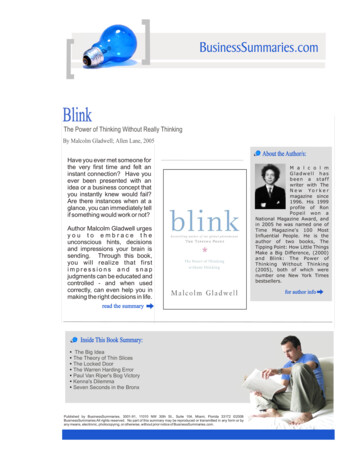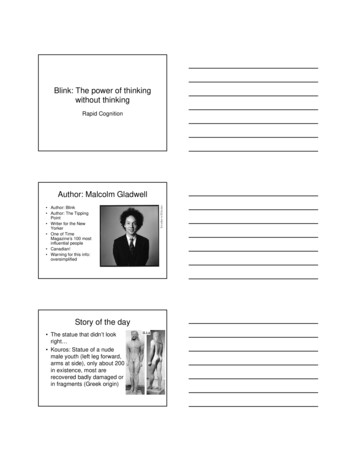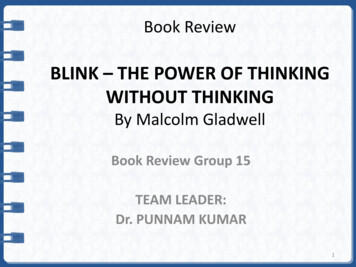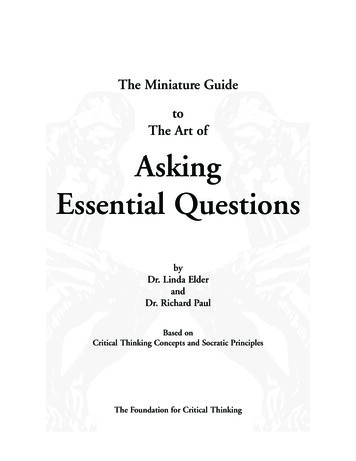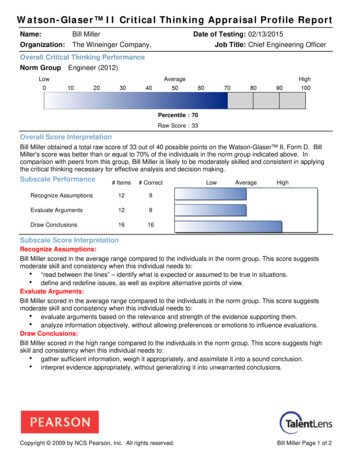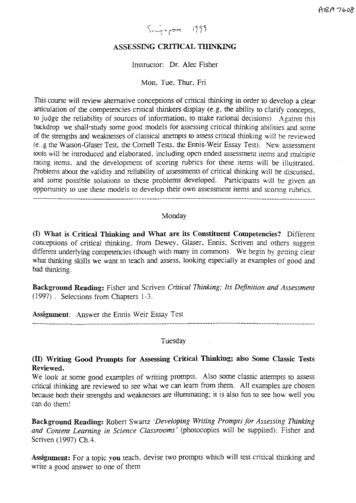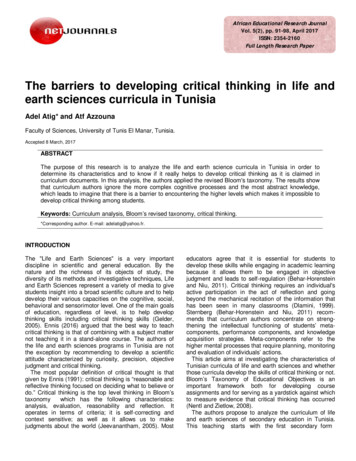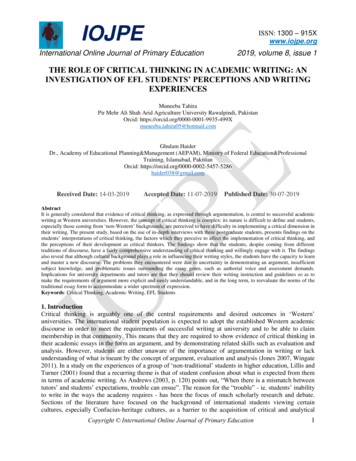
Transcription
IOJPEISSN: 1300 – 915Xwww.iojpe.orgInternational Online Journal of Primary Education2019, volume 8, issue 1THE ROLE OF CRITICAL THINKING IN ACADEMIC WRITING: ANINVESTIGATION OF EFL STUDENTS’ PERCEPTIONS AND WRITINGEXPERIENCESMuneeba TahiraPir Mehr Ali Shah Arid Agriculture University Rawalpindi, PakistanOrcid: a05@hotmail.comGhulam HaiderDr., Academy of Educational Planning&Management (AEPAM), Ministry of Federal Education&ProfessionalTraining, Islamabad, PakistanOrcid: il.comReceived Date: 14-03-2019Accepted Date: 11-07-2019Published Date: 30-07-2019AbstractIt is generally considered that evidence of critical thinking, as expressed through argumentation, is central to successful academicwriting at Western universities. However, the concept of critical thinking is complex: its nature is difficult to define and students,especially those coming from ‘non-Western’ backgrounds, are perceived to have difficulty in implementing a critical dimension intheir writing. The present study, based on the use of in-depth interviews with three postgraduate students, presents findings on thestudents’ interpretations of critical thinking, the factors which they perceive to affect the implementation of critical thinking, andthe perceptions of their development as critical thinkers. The findings show that the students, despite coming from differenttraditions of discourse, have a fairly comprehensive understanding of critical thinking and willingly engage with it. The findingsalso reveal that although cultural background plays a role in influencing their writing styles, the students have the capacity to learnand master a new discourse. The problems they encountered were due to uncertainty in demonstrating an argument, insufficientsubject knowledge, and problematic issues surrounding the essay genre, such as authorial voice and assessment demands.Implications for university departments and tutors are that they should review their writing instruction and guidelines so as tomake the requirements of argument more explicit and easily understandable, and in the long term, to reevaluate the norms of thetraditional essay form to accommodate a wider spectrum of expression.Keywords: Critical Thinking, Academic Writing, EFL Students1. IntroductionCritical thinking is arguably one of the central requirements and desired outcomes in ‘Western’universities. The international student population is expected to adopt the established Western academicdiscourse in order to meet the requirements of successful writing at university and to be able to claimmembership in that community. This means that they are required to show evidence of critical thinking intheir academic essays in the form an argument, and by demonstrating related skills such as evaluation andanalysis. However, students are either unaware of the importance of argumentation in writing or lackunderstanding of what is meant by the concept of argument, evaluation and analysis (Jones 2007, Wingate2011). In a study on the experiences of a group of ‘non-traditional’ students in higher education, Lillis andTurner (2001) found that a recurring theme is that of student confusion about what is expected from themin terms of academic writing. As Andrews (2003, p. 120) points out, “When there is a mismatch betweentutors’ and students’ expectations, trouble can ensue”. The reason for the “trouble” - ie. students’ inabilityto write in the ways the academy requires - has been the focus of much scholarly research and debate.Sections of the literature have focused on the background of international students viewing certaincultures, especially Confucius-heritage cultures, as a barrier to the acquisition of critical and analyticalCopyright International Online Journal of Primary Education1
IOJPEInternational Online Journal of Primary EducationISSN: 1300 – 915Xwww.iojpe.org2019, volume 8, issue 1skills (Ramanathan and Kaplan 1996b, Atkinson 1997, Ramanathan and Atkinson 1999). Others, such asElander et al. (2006) and Jones (2007) have argued that international students may fail to demonstratecritical thinking due to the university not explaining and teaching its discourse practices and conventionsexplicitly enough.The above discussions can offer valuable perspectives on the nature and practice of critical thinking inhigher education, and will be discussed in more detail in the review of the literature. However, in order togain a fuller understanding of the issues and complexities surrounding critical thinking, we need to obtainan ‘insider’s’, or emic perspective. Given the importance of demonstrating a critical approach in writing, itis surprising, as Wingate (2011) points out, that there has not been more research on students’ perceptionsand experiences of the challenges in implementing critical thinking in academic writing. Throughconducting a small-scale qualitative research project I aim to capture significant understandings, concernsand issues of a small group of participants in the context of a postgraduate degree programme at a Britishuniversity.The focus of the investigation is on student perceptions and experiences rather than assessing or analyzingtheir critical thinking skills, or evaluating the success of university instruction of critical thinking. My roleas both researcher and fellow student gives me an advantageous ‘insider’s’ vantage point from which toforeground my fellow students’ voices which might not otherwise be heard. The aim of the study is toglean some insights into the learning experiences and challenges that international students meet as theyadapt to a new academic discourse. By highlighting these particular complexities, I hope to raiseawareness amongst the academic staff and offer some suggestions as to better facilitate the students’expression and development of critical thinking in academic writing.In order to establish a background and a frame of reference for the study, I will review a range of researchand theorising about the nature and significance of critical thinking, and the perceived difficulties inimplementing it in writing. After discussing the methodological approaches which underline the study, Iwill present the findings of a small-scale research project. The findings will be examined with reference totheir correspondence with those of the existing literature, and will be organised and discussed under keythemes which emerged during the data analysis. There then follows a discussion synthesising the mainfindings, issues and concerns in answer to the questions the research set out to explore. Finally, theconclusion will bring together the most pertinent insights which emerged from the research and outlinesome implications for academic departments.2. Literature ReviewResearch on academic composition has increasingly questioned the nature and value of critical thinking inanglophone academic practices, much of it focussing on the challenges which international students facein developing and implementing a critical dimension in their writing (see Zamel 1993, 1995, Fox 1994,Casanave 2004).In order to provide a relevant context to examine these challenges, I will first explore some of thecomplexities in understanding the concept of critical thinking and discuss its role in anglophone academicdiscourse. Next, I will provide an overview of the two main bodies of theory underpinning criticalthinking. In the final section, I will review the main difficulties associated with expressing criticality inwriting.Copyright International Online Journal of Primary Education2
IOJPEInternational Online Journal of Primary EducationISSN: 1300 – 915Xwww.iojpe.org2019, volume 8, issue 12.1. The nature of critical thinkingEven though the words ‘critical thinking’ convey a general idea of what it entails, it remains a conceptover which there is much uncertainty and contention about what it encompasses and how it is manifested.This is evident by the numerous ways it is defined.In broad terms critical thinking is viewed as a cognitive skill related to rational judgement, defined as “theeducational cognate of rationality” Siegel (1988 in Jones 2005), “reflexive skepticism” (McPeck 1981)and “critical self-reflection” (Barnett 1997 in Tapper 2004, p. 201).Toulmin, Rieke and Janik (1984 in Andrews 2000, p.5) associate critical thinking with reasoning, used for“the central activity of presenting reasons in support of a claim.” This type of logical argumentation canbe taught through syllogisms (Davies 2008), but as Wingate (2011) points out, syllogisms are mostlysuitable for single claims, rather than for the large-scale structure of the essay.When it comes to university contexts, critical thinking is defined in terms of abilities or skills such asselection, evaluation, analysis, reflection, questioning, inference and judgement (Tapper 2004). Despitethe many diverging views on the nature of critical thinking, there is consensus in the literature that criticalthinking is exhibited through the students’ abilities to “identify issues and assumptions, recogniseimportant relationships, make correct inferences, evaluate evidence or authority, and deduce conclusions”(Tsui 2002, p.743).When critical thinking is applied to writing, the above abilities are expressed through the process ofargumentation, producing an argument i.e. the essay, the dissertation. Argument can be defined as aconnected series of related ideas “intended to establish a position and implying response to another (ormore than one) position” (Andrews 1995, p.3). Argument is regarded as the primary expression of criticalthinking in higher education (Andrews 1995, Scott 2000), and the defining feature of the essay (Elander etal. 2006). As Bonnett (2001, pp.50-51) emphasizes: “Your essay is your argument, everything else makessense because of it”.Despite the importance of presenting an argument in academic writing, students still lack an understandingof its implementation or labour under misconceptions. Elander et al. (2006) point out that in a previousstudy the majority of the students felt that argumentation means presenting their own original views oropinions. As Branthwaite et al. (1980) point out, the need for ‘original’ thought is more likely to beemphasized by students as it is by tutors, who generally do not regard ‘originality’ as a key criterion ofsuccessful academic writing. Another popular misconception is that argumentation is manifested solelythrough an adversarial stance in writing, by overtly criticising scholars’ research or claims. However, asAndrews (1995) explains, an argument should be sensitive to, and engage with other points of view:evaluating, rather than criticising the sources, and incorporating those claims which are closest to theirown position.Adding to the confusion around the concept of argumentation is the tutors’ own uncertainty in articulatingwhat a well-developed argument entails. Mitchell et al. (2008) report that when interviewing universitytutors, they used non-specific descriptions and vague terms such as critique, critical analysis, and opinionas terms of explanation. Furthermore, Mitchell and Riddle’s study (2000 in Wingate 2011) shows thatthere is a general lack of clarity in feedback comments on student essays, the markers using both thesingular and plural forms of the term ‘argument’ interchangeably, thereby not making it clear that it is theCopyright International Online Journal of Primary Education3
IOJPEInternational Online Journal of Primary EducationISSN: 1300 – 915Xwww.iojpe.org2019, volume 8, issue 1development of an overarching position (i.e. an argument), rather than individual claims (i.e. arguments)which produces a successful essay.What is therefore needed from a pedagogical perspective is not only a definition of critical thinking orargument, but descriptions of core characteristics of essays which demonstrate critical thinking. In thisregard I turn to Wingate’s (2011) three components of argumentation, a three-step description ofdeveloping an argument. It is useful in presenting a clear and easily understood set of abilities studentwriters need in order to write effective argumentative essays. The first component is “analysis andevaluation of content knowledge” (p.2). This relates to the ability of selecting relevant information fromthe literature to substantiate the writer’s argument. The second component is “the writer’s development ofa position”, i.e. argument (p.2). The writer needs to present a considered position, usually establishedthrough the writer’s ‘voice’, or stance. The third component is “the presentation of the writer’s position ina coherent manner” (p.3). This pertains to the logical arrangement of propositions at the structural level,usually presented through the default academic genre of the essay or dissertation.The difficulties which students may experience with these three components of developing an argumentwill be examined further on.As is evident from the above definitions and descriptions, critical thinking is a concept with a widebreadth, encapsulating both a social activity and a cognitive operation. It reveals itself in an essay throughargumentation, the process by which a text transforms other texts, thereby not merely reproducingknowledge, but reconstructing knowledge.2.2. The significance of critical thinking in higher educationCritical thinking is regarded as a highly valued outcome of tertiary education. Outside of university study,employers seek graduate employees who are able to transfer their critical thinking abilities to theworkplace (Tapper 2004). Other scholars such as Elander et al. (2006) believe that critical thinking skillsare not merely transferable to other areas of our lives, but also personally transformative, inducingindividuals to develop from passive recipients of knowledge to active, participants in society.However, one has to bear in mind that those international students who come from cultures where criticalthinking is not encouraged or appreciated, might find it neither helpful nor advisable to adopt a criticalthinking approach outside of their academic pursuits.Andrews and Mitchell (2001) and Lillis (2001) maintain that argument assists in the learning process,enhancing and consolidating students’ understanding of a subject. By encouraging students to argue and toquestion, both in spoken and written form, they are given a sense of control over their own learning, whichleads to increased confidence and autonomy. Broadly, argument provides a means to circumscribe andassess the knowledge which is produced within the academy, and more specifically, a way for tutors togage their students’ understanding of the subject matter.However, it is not enough for students to know that critical thinking is a key criterion of a high-scoringessay, they should also know why and how critical thinking is useful to their general development as astudent. In this way, the student is not just blindly adopting the academic conventions of a Westernuniversity, but is consciously employing the critical thinking tools they are offered to gain most benefitfrom their studies.Copyright International Online Journal of Primary Education4
IOJPEInternational Online Journal of Primary EducationISSN: 1300 – 915Xwww.iojpe.org2019, volume 8, issue 1Although there is much agreement on the significance of critical thinking, its general relevance andapplicability is a question which has engendered much debate. In the following section I investigate thisdebate in more detail.2.3. The theoretical constructs of critical thinkingSince Kaplan’s study (1966), comparing thought patterns between different cultures, there has been someevidence in subsequent research that cultural differences in approaches to thinking and learning styles doexist. This cross-cultural comparison formed the basis of what came to be known as contrastive rhetoric(CR), a discipline which maintains that “different language communities represent different cultures andliteracy practices” (Canagarajah 2002). The research identifies critical thinking as a prime distinguishingfeature between Anglo-American academic models and ‘non-mainstream’, or Confucian-based learningsystems (Cadman 2000, Egege and Kutieleh 2004). According to this finding, students from Asiancountries or ‘Confucian-heritage cultures (CHC) such as China, Vietnam, Korea, Singapore and Japanavoid a critical approach to academic texts and are considered to lack an awareness of what is involved incritical analysis and reflection (Biggs 1987, 1994, Ballard and Clanchy 1991). The non-criticality of thesecultures has largely been attributed to their educational system based on rote-learning, and their deferenceto teachers and scholars, where any critique can be construed as being impolite and disrespectful(Andrews, 2007).This cultural construct of critical thinking has engendered much debate amongst scholars as to thepedagogical implications of critical thinking: firstly, to what extent does a particular culture support orinhibit critical thinking, and secondly, whether it is possible and appropriate to teach critical thinkingskills to individuals from so-called non-critical communities. The main arguments can roughly be dividedinto two opposing constructs: one presents critical thinking as a universally essential skill, the other viewsit as specific to Western culture.The first construct conceives of critical thinking in broad terms, characterizing it as “a basic humansurvival mechanism”, applied by all societies, some to a greater degree than others (Casanave 2004,p.206). Those who promote this construct are of the view that the ability to think critically is not onlycentral to a good education, but also integral to engaging with the world as a reflective and active citizen(Moore 2004). This widely-held perspective is exemplified by the National Council for Excellence inCritical Thinking Instruction (2003) who states that:In its exemplary form [critical thinking] is based on universal intellectual values that transcend subjectmatter divisions; clarity accuracy, precision, consistency, relevance, sound evidence, good reasons, depthand fairness.Critical thinking is thus conceived as a self-evidently useful skill, one which is desirable, beneficial andachievable, and most importantly, universally valued. Pertaining to its pedagogical applicability, Angeloand Cross (1993 in Egege and Kutieleh 2004, p.79), advocate that the ability to think critically is the primegoal of the liberal arts and general education, and should be applied to “virtually all methods of inquirypracticed in the academic disciplines”.The assumption that critical thinking is a neutral, universally valued skill is however, problematic. AsEgege and Kutieleh (2004) observe, the cognitive capacity to reason is something which all human beingsare considered to possess. Nevertheless, this does not mean that good reasoning and analytical skills areembraced by all cultures and valued in the same way. And moreover, even if one takes the view thatreasoning skills are universally appreciated, the evidence of such reasoning skills is not universal. WhatCopyright International Online Journal of Primary Education5
IOJPEInternational Online Journal of Primary EducationISSN: 1300 – 915Xwww.iojpe.org2019, volume 8, issue 1counts as critical thinking in the West - the techniques of analysis and evaluation, the style and linearstructure of the written argument is in fact part of a Western cultural tradition originating from the ancientGreeks.In teaching non-mainstream students, it is thus important to acknowledge that critical thinking as it ispracticed in the West is not universal, but should rather be seen in the context of the historical, politicaland social conditions in which it is embedded.The second construct of critical thinking is a critique on precisely this notion of a neutral, universallydesired skill. In contrast, it presents critical thinking as a culturally-specific, uniquely Western concept, anability which people develop unconsciously as they are socialized in their Anglophone cultures. Thescholars who advocate this approach question whether it is appropriate to impose critical thinkingpedagogies on L2 learners who come from a different culture (Atkinson and Ramanathan 1995,Ramanathan and Kaplan 1996a, 1996b, Atkinson 1997).Atkinson’s (1997) argument is based on 4 premises: firstly, he characterises critical thinking as a tacitsocial practice, which the individual learns intuitively, “through the pores” (p. 73), by virtue of growingup in a Western culture. It is therefore difficult to pinpoint and define, and not easy, if at all possible, toteach. Second, Atkinson argues that critical thinking is “exclusive and reductive” (p.77). Far from being auniversally applicable skill, it reduces useful thinking skills to (in) formal logic, thereby excluding andmarginalizing many groups, including women who may not be comfortable with its “masculinity”,adversarial nature (p. 78). Third, he stresses that teaching critical thinking to people from non-Westernsocieties may be fraught with problems, due to the fact that the related notions of individualism and selfexpression are alien to non-Western writers. He concludes with his fourth assumption, namely that criticalthinking skills, once taught, do not appear to be transferable to contexts outside the learning environment.In a study undertaken by Ramanathan and Kaplan (1996b), they analyze Li composition textbooks, notingthat the textbooks emphasize informal logic, and promote the use of concepts like voice, argumentationand critical thinking. They conclude that these texts are therefore not suitable for L2 student writers,stating that L2 writers would have difficulty with the critical thinking tasks which require analyses andreflection- skills which did not form part of their socialization or education:L2 student-writers [.] are more likely than native English speakingstudents to encounter difficulty when inducted into critical thinkingcourses in freshman composition classes. They are not “ready” for criticalthinking courses in either Li or L2 writing courses (p. 232).This would imply that Ramanathan and Kaplan view the non-mainstream culture of the L2 student writersas a barrier to the acquisition of critical and analytical skills.The above arguments are in line with the contrastive rhetoric approach and the related studies haveproduced some useful findings on the differences in writing practices between non-native and Anglophonecommunities (see Ramanathan and Kaplan i996b). CR takes into account the students’ linguistic andcultural milieu, making teachers aware and giving them an insight into the challenges which L2 studentsface with language and writing. This relativist approach avoids thinking of academic practices as neutralconstructs to be adopted by everyone in every context. Rather, it takes the students’ culture seriously andis more tolerant and understanding towards different writing conventions or rhetorical deviations (see Foxi994).Copyright International Online Journal of Primary Education6
IOJPEInternational Online Journal of Primary EducationISSN: 1300 – 915Xwww.iojpe.org2019, volume 8, issue 1The popularity of approaches like CR points to the fact that educators pay great attention to differences inacademic writing practices. However, as Casanave (2004) points out, there has also been a lot of critiquein the literature against the condescending portrayal of L2 writers as “not ready” or having difficulty inthinking critically in either Li or L2 (Ramanathan and Kaplan i996b). L2 specialists have taken issue withthe cultural and linguistic determinism underlying the arguments of scholars such as Atkinson, Kaplan andRamanathan. Zamel (i997) and Canagarajah (2002a) do not agree that students’ cultural and linguisticbackground should be viewed as making them less capable of critical thought or analysis, and preventingthem from becoming successful writers in English. Instead of being bound by their languages and cultures,Canagarajah (2002b, p.101) argues that “everyone has agency to rise above their culture and socialconditions to attain critical insights into their human condition”. Zamel (1997) and Davidson (1998) takefurther issue with a perspective which cautions teachers against imposing Western analytical skills ofcritique and reasoning on students who come from communities which do not practice these skills.Davidson (1998) argues that it is the teacher’s responsibility to prepare learners for meeting the demandsof academic writing at university, and if the university expects critical thinking skills to be displayed, thenthey need to be made explicit and taught.Another criticism against this approach is its static and homogenous perception of culture in general, andthe L2 writer in particular. Canagarajah (2002a, p.35) argues that one should not overlook “theconsiderable hybridity and heterogeneity evident in each community”. He goes on to explain thatglobalization has resulted in spreading Anglo-American values and institutions to other communities. Inaddition, people are moving between different communities and have multiple memberships, and thus it isimpossible to pinpoint their diverse cultural and linguistic traits to one immutable set of values. Thereforethe cultures of different communities cannot be treated as separate and uniform.The same conclusion is reached with regards to writing practices, specifically focusing on Chineserhetoric. Current studies have suggested that modern Chinese academic writing is not monolithic ordiametrically opposed to Western writing, but in fact shows some similarities in structure to that ofWestern texts (Kirkpatrick 1997, Jones 2005). This suggests that there is notable interchange betweenWestern and Chinese academic practices. Canagarajah (2002b, p.64) makes a particularly salient pointwhen he observes that even though students may prefer certain practices of text construction based ontheir own traditions, they can still “creatively negotiate” the dominant Western practices they areintroduced to.In review of this debate, it is important to make clear that neither approach suggests that there are nodifferences between Anglophone and non-Western cultures as pertains to academic practices. There isgeneral consensus that students will face and even resist unfamiliar writing norms in new educationalcontexts (Zamel 1997). Canagarajah (2002b, p. 68) draws attention to the proposition that “The moreimportant consideration in critical writing is not difference per se but the attitudes we adopt towarddifference”. We need to avoid treating the rhetorical differences of international students as a deficit in aWestern academic environment.That brings me to the next section in which I address some of the factors which have been identified in theliterature as potentially being problematic for both mainstream and international students in implementinga critical dimension in their writing.Copyright International Online Journal of Primary Education7
IOJPEInternational Online Journal of Primary EducationISSN: 1300 – 915Xwww.iojpe.org2019, volume 8, issue 12.4. Difficulties in expressing criticality in academic writingThere is little controversy about the importance of academic writing in higher education. It is regarded asthe means for students to explore and consolidate their understanding of the subject knowledge, as well asa way for tutors to gage their students’ understanding and engagement with the subject. However, as Lillis(2001) remarks, student writing is increasingly serving the purpose of gate keeping. Students, especially atpostgraduate level, are in most cases assessed solely on their writing, either passing or failing coursesaccording to how they respond to the writing tasks.This holds serious implications for both Li and L2 writers, but especially for L2 international students whomay well not be familiar with the criteria of Western academic discourses.Since the presentation of an argument is a key criterion of successful writing at higher education, I willlook at the three components of developing an argument as identified in chapter 2.1, and the difficultiesassociated with implementing each component.Firstly, I examine the problem of insufficient subject knowledge, since it directly affects the ability ofstudents to analyze and evaluate content knowledge (the first component of argumentation). Next I discussthe difficulties which students have with manifesting their presence, or authoritative ‘voice’ in writing,essential in establishing a position (the second component). I go on to look at the complexities ofdeveloping and presenting an argument (the third component), within the structure of the essay form. Icritically examine the essay genre, looking at the challenges this textual form presents to students and towhat extent it supports or inhibits the expression of an argument.2.4.1. Subject knowledgeSufficient subject knowledge has been regarded as an essential requirement for the development of criticalthinking skills. It can be seen as the fertile soil on which the seed of critical thinking can take root andgrow. As Garside (1996, p.215) points out, “Since it is impossible to think critically about something ofwhich one knows nothing, critical thinking is dependent on a sufficient base of knowledge”.In discussing the challenges which both Li and L2 writers face, some scholars have identified lack ofsubject knowledge as one of the key impediments to developing an argument in writing (Andrews 1995,Wingate 2011). In the Confucian-heritage tradition, students first need to acquire sufficient subjectknowledge before they can attempt to develop their own position within their field (Andrews 2007).Acquiring subject knowledge is therefore the crucial initia
thinking in higher education (Andrews 1995, Scott 2000), and the defining feature of the essay (Elander et al. 2006). As Bonnett (2001, pp.50-51) emphasizes: “Your essay is your argument, everything else makes sense because of it”. Despite the importance of presenting an argument in academic
